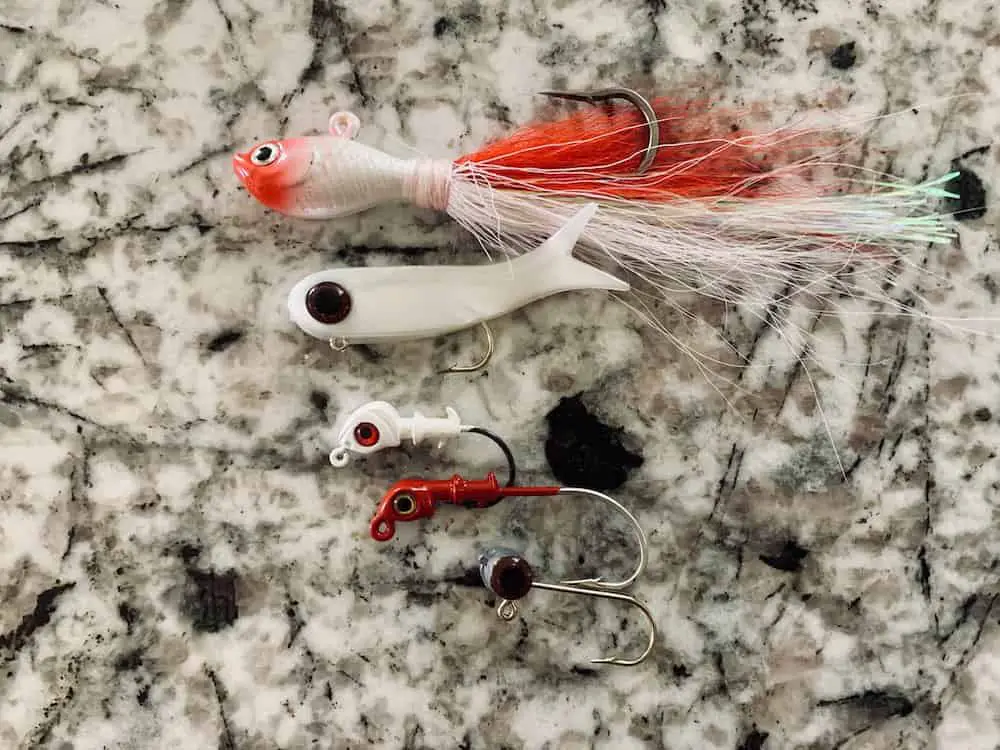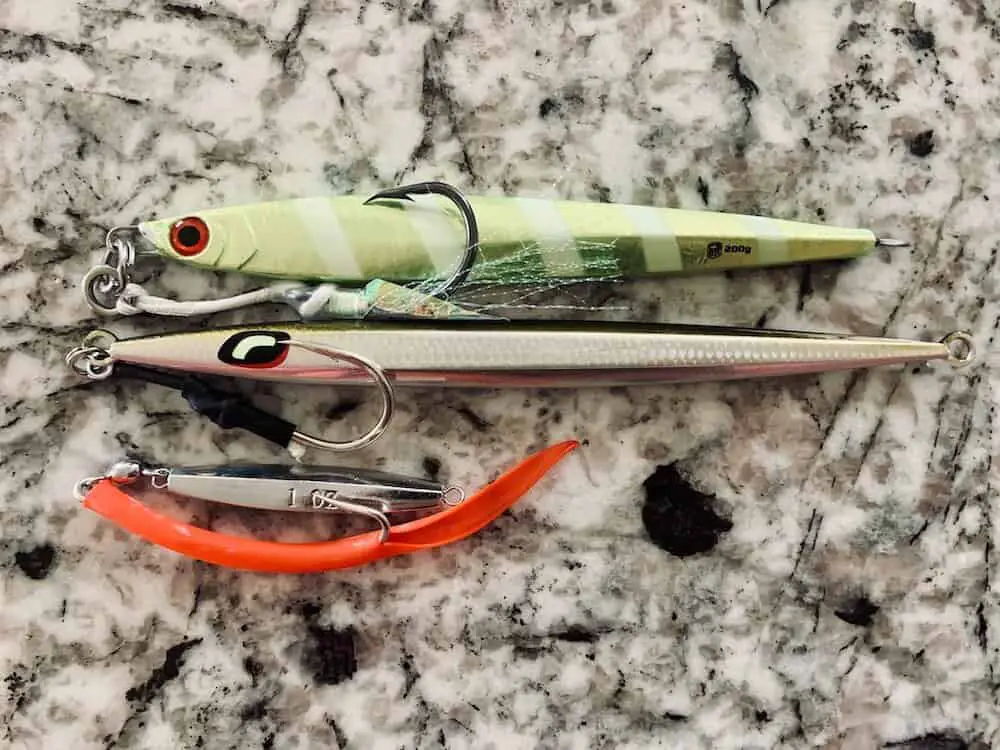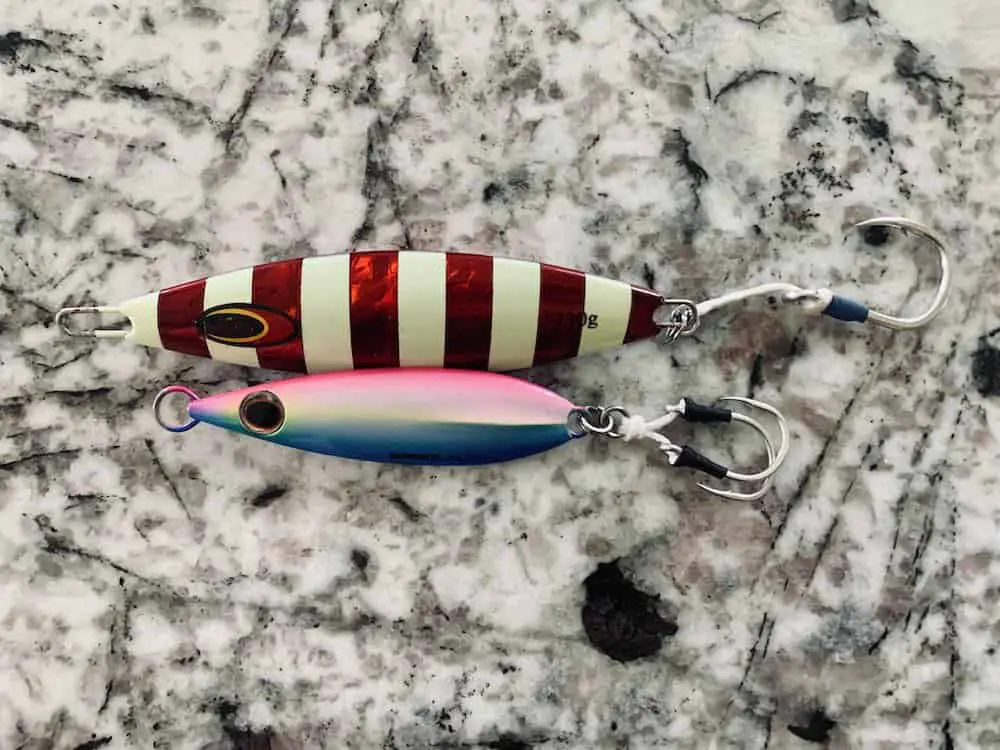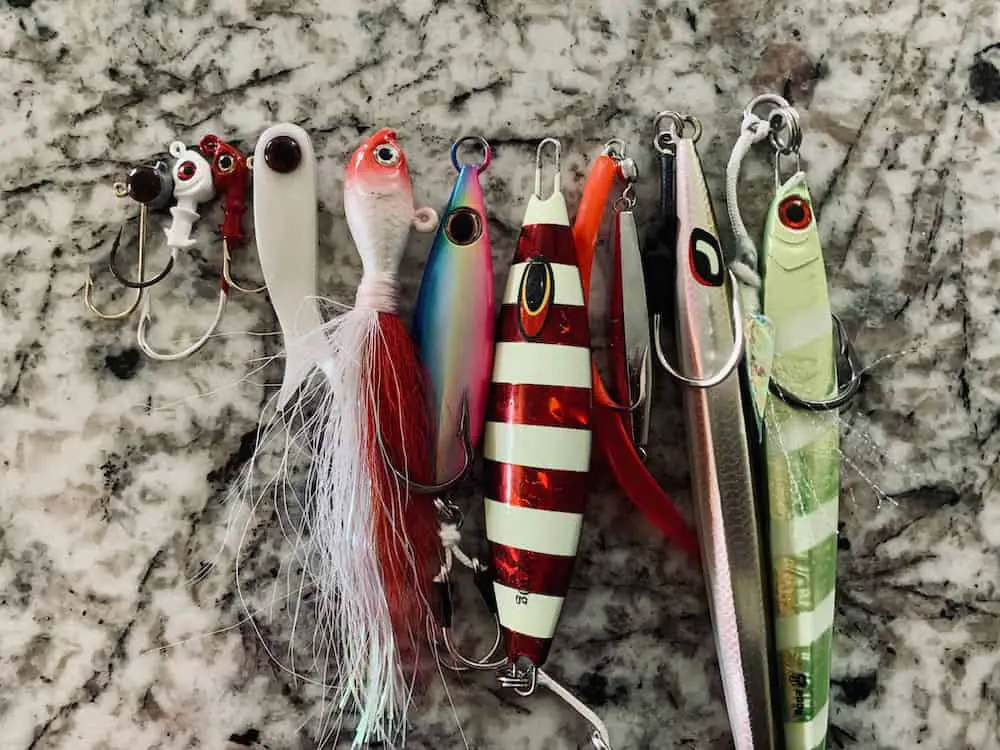Jigs are some of the most versatile fishing lures you can buy. They can be used for jigging, casting, and even trolling. They’re well known in the world of freshwater fishing for bass, walleye, crappie or perch, which makes a lot of anglers wonder what is a saltwater jig? A saltwater jig is either a jig head, a long and slender speed jig, or a wide and flat slow jig made with corrosion resistant hardware. For bottom dwelling species, flat and slow jigs, or jig heads paired with soft plastics are the best options, and for mid-depth species, speed jigs are better. The massive variety of jigs on the market can confuse novice anglers trying to stock a tackle box for jigging. Long and slender jigs are used for a completely different jigging technique than wide and flat jigs. Read on to learn more about the different styles of jigs and what technique to use.
Use Jig Heads for Bottom Bouncing or Trolling
A jig head is often used for bottom fishing and is commonly paired with a soft plastic paddletail. The jig head gives the soft plastic some weight to help it drop to the bottom and also dictates whether the paddletail falls horizontally or dives down. Soft plastics and jig heads imitate shrimp and other crustaceans and are frequently used to target bottom feeding saltwater species such as flounder. Jig heads with a worm hook can be rigged in a weedless fashion to create a great lure option when fishing in the midst of mangrove trees or seagrass.

Some jig heads have small wire or metal to hold the soft plastic or bait in place. This feature is called a “bait keeper”. Bait keepers on jig heads are especially effective when trolling. A jig head with a bait keeper helps to keep your bait attached to the hook and jig head when it’s being pulled back during the troll.
Jig heads are sometimes used when trolling in saltwater. The weight of the jig head keeps the bait at the desired depth with the advantage of being right next to the bait. Sometimes a trolling lead will be used to get a bait to depth, but that method can be frustrating because once you reel in enough to get to the lead, you need to hand line in the rest of the leader.
Bucktail jigs are a type of jig head with synthetic feathers as a teaser. Because of the teaser, bucktail jigs are not paired with paddletails. Bucktail jigs are effective in saltwater when trolling, bottom bouncing, and jigging around structure. Most often, I’m jigging around structure and using SPRO bucktail jigs with teasers, and jig heads paired with soft plastics.
Pair Slender Jigs with a Speed Jigging Technique
When doing a speed jigging technique, you’ll need a short and stout rod with a long butt section so it fits under your armpit. The long and slender jig falls quickly and vertically to the bottom. Then the technique requires a fast jig up, immediately followed by quickly retrieving the slack line as you bring the rod tip back down. This jig up and retrieve pattern is repeated until the jig or fish is retrieved. The jig will dart erratically during the retrieve and is usually hit hard by striking fish on the way up. Speed jigging with long and slender, tail-weighted jigs with strong assist hooks is usually done near drop offs or reefs and is used to target fish saltwater throughout the entire water column.
Diamond jigs with a nylon tube are also used in saltwater. These jigs are allowed to drop to the bottom and then the angler quickly jerks it up and creates a sand commotion off the bottom to mimic the behavior of an eel. I usually choose a red color tube and a bright silver diamond jig so the flash will also help attract a fish. I remember one time I was fishing for grouper with my dad and used this method and took home one of the biggest groupers I’ve ever caught. It was a hard strike and for a moment I thought I lost the jig, but luckily, I didn’t. Read about how to choose a speed jigging rod in my article, Top 7 Saltwater Jigging Rods.
My favorite speed jigs are the Shimano Shimmerfall, the Ocean Tackle International Ricochet Jig, and the Sportfish Diamond jig with tube.

Choose Wide, Flat Jigs for Slow Pitch Jigging Offshore
Slow pitch jigs are relatively new to the market. In slow pitch jigging, the angler begins by allowing the jig to drop to the bottom. The technique is usually done in 100+ feet of water offshore. The jigs will lay horizontally and wobble as they fall to imitate a dying baitfish. The fish will strike the jig as it falls. This is primarily an offshore technique, so you’ll find that the slow jigs on the market have some of the best corrosion resistant hooks.
The oval shaped, flat sided jigs with bold color patterns are the style you’ll need for slow pitch jigging in saltwater. The sizes are generally displayed in grams, and a good rule of thumb is 100 grams per 100 feet of water depth. You may need to increase the size if the current is so strong that it causes too much slack your line. It can be tricky, but you need to let the jig fall in freespool with just enough tension that you’ll be able to feel a soft strike.
Slow pitch jigging requires the use of a specialized setup. You’ll need a lightweight, fast retrieve reel with a slow action rod. To learn more, check out my article How I Chose My Slow Pitch Jigging Rod, Reel and Jigs.

My favorite slow jigs are the Nomad Buffalo jig, and the Shimano Butterfly Flat Fall jig.
I hope this article helps you understand what a saltwater jig is. Read my article on Jigging Leaders: Why You Need One and How to Choose It to learn how to rig one up!
Recent Posts
Fat Cow Jig Strips: The Ultimate Bucktail Jig Upgrade for Surf Fishing
As discussed in my previous article, "Surf Fishing with Bucktail Jigs: Ultimate Guide for Beach Anglers," bucktail jigs are a staple in any surf angler's tackle box, offering a versatile way to catch...
In my previous article, "Surf Fishing with Bucktail Jigs: Ultimate Guide for Beach Anglers," I introduced you to the bucktail jig and discussed how versatile of a lure it is for catching a wide range...

